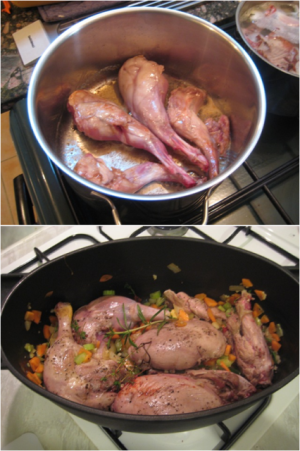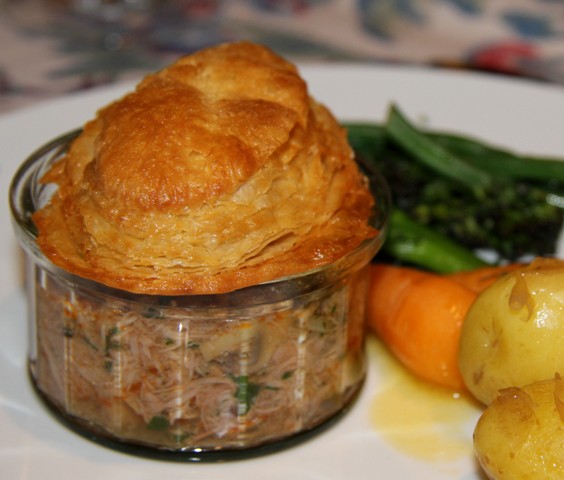From Angela Hartnett's Rabbit pappardelle to duck pie
 Monday, October 4, 2010 at 9:27PM
Monday, October 4, 2010 at 9:27PM 
A couple of people have requested the recipe for the rabbit ragù that I made when I was in France. The recipe is another of my favourites from Angela Hartnett’s Cucina. In Hartnett’s recipe she uses the ragù as a sauce for pappardelle, as is traditional in the Emilia-Romagna region:
This is a very rustic creation from Emilia-Romagna, and in my view there’s no tastier pasta dish in Italy. The rabbit is slowly roasted, then stewed to make the most fantastic, rich meat sauce, and it’s served with wide ribbon noodles called pappardelle.
I agree that the rich meat sauce is delicious with pasta, but I have also taken to using it as a pie filling in the colder months.
 I have made this ragù many times, but until my recent visit to France I had always used duck as a substitute for rabbit. Would you respect me more if I said I did this because I think the taste and texture of duck meat to be far superior? Probably, but in reality it was simply a matter of convenience. I could have gone to the butcher, but my local Sainsbury’s sells whole Gressingham ducks at half price on a regular basis, so I almost always have one in the freezer.
I have made this ragù many times, but until my recent visit to France I had always used duck as a substitute for rabbit. Would you respect me more if I said I did this because I think the taste and texture of duck meat to be far superior? Probably, but in reality it was simply a matter of convenience. I could have gone to the butcher, but my local Sainsbury’s sells whole Gressingham ducks at half price on a regular basis, so I almost always have one in the freezer.
I felt I ought to try the original recipe before putting it up on the blog. Now that I have done so I can safely say that it works equally well with either meat. Wild rabbit or duck is preferable in both cases, as it tends to be more flavoursome than farmed meat; it is this rich, gamey quality that makes this sauce so hearty and satisfying.
When I use the ragù as a pie filling, I usually add some mushrooms towards the end, chestnut or Portobello work well. This has as much to do with the extra dimension that they add texturally, as it has to do with flavour. If you want to try the pie, you will also need a half portion of rough puff pastry. The method that I use for this pie is the same as for my chicken, leek and bacon pie.
The recipe below is as it appears in the book, except that I have left out the instructions for the pappardelle. This is because:
In the absence of a choice d, all of the above, the most correct answer is b, for which I have a good excuse: I do not have a pasta machine and Hartnett, unlike some other misguided enthusiasts, does not suggest an alternative. I have tried it once without a machine and all I can say is never again; I simply do not believe that anyone can get pasta to the correct thickness using a rolling pin. You can buy fresh pasta in most major supermarkets these days and if they don’t stock pappardelle, tagliatelle makes a good substitute. Otherwise, I just did a quick Google search which produced loads of hits for online retailers.
Hartnett advises that the pasta serves 4 to 6; I would say it serves 4 for either pasta or pie, as your guests will undoubtedly want seconds!
Ingredients
Method
Season the rabbits legs. Heat the olive oil and butter in a pan, add the rabbit legs and brown on all sides. Remove the rabbit from the pan, add the vegetables, garlic and herbs and cook for 4-5 minutes, or until evenly coloured.
Return the rabbit legs to the pan and add the tomato puree. Cook for 2 minutes, then add wine and turn up the heat to bubble and reduce.
Pour enough stock to cover, then place a cartouche (a circle of baking parchment) on top and cook on a low simmer until the meat comes away easily from the bones. This will take about 45 minutes. Remove the rabbit and set aside until cool enough to handle. Lightly shred the meat into small pieces. Discard the bones.
Strain the stock, discarding the vegetables, and return to a clean pan. Add the rabbit pieces to the stock and place over a medium heat. Simmer until reduced and thick.

If you are serving the ragù with pasta, the recipe also includes some freshly grated parmesan as a garnish. As for the pie, root vegetables, such as beetroot, carrot or parsnips make great accompaniments, or for a lighter alternative try green beans, purple sprouting broccoli or asparagus.
 Vix |
Vix |  2 Comments |
2 Comments | 
Reader Comments (2)
FINALLY the recipe for rabbit ragu. Thanks. I have been waiting impatiently since I tasted yours in France. It was truly outstanding (and this from someone who does not eat much meat). Will let you know how it goes. I'll make it for Joe's welcome home from Australia dinner next week. Do you remember if it is the blue eyed or the black eyed rabbits that are so superior in flavour and texture ? I remember well the lecture from the butcher in Provence, but not the outcome.
I'm afraid I cannot remember. When we went to find said butcher they had no rabbit and they laughed at us when we asked about the eyes. I think we were either in the wrong butchers or they were imposters! The rabbit I bought from the supermarket had black eyes and that was nice... Let me know how it goes.